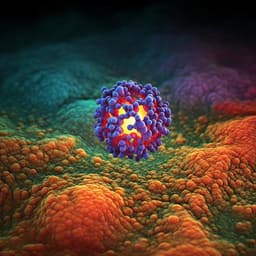
Medicine and Health
Enhanced plant-derived vesicles for nucleotide delivery for cancer therapy
S. Corvigno, Y. Liu, et al.
This exciting research showcases the development of a hybrid exosomal polymeric system (HEXPO) using plant-derived vesicles, promising a breakthrough in cancer therapy by effectively delivering small RNAs. The study, led by a team of experts including Sara Corvigno and Anil K. Sood, highlights the anti-angiogenic potential of miR146a in combating cancer.
~3 min • Beginner • English
Introduction
The therapeutic use of small RNAs is expanding, but delivery in oncology remains challenging due to rapid clearance, poor tumor microenvironment (TME) targeting, and biocompatibility issues. While mammalian extracellular vesicles (EVs) have been considered as delivery vehicles, concerns about immunogenicity, low loading efficiency, yield, and cost limit their clinical translation. Plant-derived vesicles (PDVs) are biocompatible, can be taken up by mammalian cells, and are relatively easy to isolate at scale. This study develops a PDV-based delivery system, combining watermelon-derived PDVs with a cationic generation 3 PAMAM dendrimer to load and deliver a therapeutic miRNA (miR-146a-5p). The hypothesis is that a hybrid exosomal polymeric system (HEXPO) can efficiently deliver miR-146a to the TME to inhibit tumor growth, in part through anti-angiogenic mechanisms.
Literature Review
Background literature highlights that EV-mediated communication is central to physiology and disease, and EVs have been explored as carriers for nucleic acids. However, mammalian EVs face challenges including immunogenicity, low loading efficiency, low yield, high cost, and lack of standardized isolation methods. PDVs, with sizes ranging from ~50–1000 nm, are stable in vivo, edible-plant-derived, and can be isolated by tissue disruption and differential ultracentrifugation; they possess intrinsic therapeutic properties like anti-inflammatory and antioxidant effects. Prior studies have proposed PDVs (e.g., from ginger and grapefruit) as drug vehicles. Hybrid nanoparticles have demonstrated flexibility and efficient loading in biomedical applications. This context motivates a scalable, biocompatible PDV-based hybrid platform for miRNA delivery in cancer.
Methodology
Plant source selection: Edible plants were screened using criteria of availability, low allergy potential (Mayo Clinic list), low retail price (USDA), absence of known drug interactions (literature), high PDV particle yield, and high cellular uptake. PDVs from nine plants were isolated and quantified (particles per gram tissue). Four sources with highest yield (>1×10^7/g: lemon, honeydew, corn, watermelon) were tested for uptake in cell types relevant to ovarian cancer TME (ID8 mouse ovarian cancer cells, MOECs, murine CAFs, THP-1-derived macrophages) via fluorescence and flow cytometry. Watermelon PDVs showed consistently higher uptake and were selected. In vivo biodistribution of CellMask Deep Red-labeled watermelon PDVs (1×10^12 particles, intraperitoneal) was assessed in the ID8 peritoneal tumor model with imaging 12 h post-injection; tumor sections were co-stained for cytokeratin.
HEXPO formulation and characterization: Generation 3 PAMAM dendrimers were complexed with miRNA at an N/P ratio of 1:25 in 5% dextrose to form dendriplexes, then incorporated into watermelon PDVs at a 1:1 ratio to create HEXPO nanoparticles. Characterization employed nanoparticle tracking analysis (NTA), transmission electron microscopy (TEM), and zeta potential (near-neutral). Complexation and component incorporation were evaluated by agarose gel retardation, spectrophotometry, and small-particle flow cytometry with rigorous controls (unstained, single-color, FMO; compensation beads; BODIPY-stained PDVs; Cy5-labeled beads; FITC-labeled PAMAM). Uptake in ID8 cells of free Cy5-miRNA vs HEXPO-delivered miRNA was compared by microscopy and RT-qPCR. In vivo biodistribution of HEXPO carrying fluorescent miR control was assessed in ID8 tumors after intraperitoneal dosing.
Therapeutic miRNA selection: Differential miRNA expression analysis using GEO dataset GSE131790 (HGSC vs normal fallopian tube) identified 20 miRNAs with logFC >3.5 (p<0.00015) up in normal tissue. Survival association (kmplot.com) highlighted miR-148a-5p and miR-146a-5p as favorable (p<0.01). Pathway analysis (miRPathDB) linked miR-146a to angiogenesis and inflammation/immunity, particularly negative regulation of blood vessel formation. TCGA analysis showed low miR-146a expression in ovarian cancer, supporting selection of miR-146a for therapy.
In vivo efficacy studies: Three intraperitoneal ovarian cancer models were used: ID8 (C57BL/6), A2780 (athymic nude), OVCAR8 (athymic nude). After tumor establishment (7 days for ID8 and A2780; 14 days for OVCAR8), mice were randomized to HEXPO-miRctrl or HEXPO-miR146a. Dosing: 10 µg miRNA (~0.4 mg/kg) per treatment, intraperitoneally, twice weekly. Endpoints included tumor weight, number of nodules, body weight; microvessel density by CD31 immunohistochemistry; toxicity via serum hepatic/renal markers; CD8+ T-cell IHC in ID8 tumors.
In vitro angiogenesis assays: Endothelial RF24 cells were subjected to tube-formation assays following (a) direct transfection with miR-146a or miRctrl, and (b) exposure to conditioned media (CM) from A2780 or OVCAR8 cells transfected with miR-146a or miRctrl. In vivo Matrigel plug assay in nude mice compared angiogenesis induced by PBS, rhVEGF, CM from A2780-miRctrl, and CM from A2780-miR146a; hemoglobin content quantified. Angiogenesis array (R&D ARY007) measured secreted factors including SERPINE1 from CM. qPCR assessed IRAK1 and SERPINE1 mRNA in tumor cells; Western blot quantified IRAK1 protein; ELISA quantified SERPINE1 protein. RNA-seq (Illumina) on RF24, A2780, OVCAR8 after miR-146a or miRctrl transfection; DESeq2 used for differential expression; pathway enrichment via clusterProfiler.
PDV isolation: Plant tissues were disinfected, homogenized, filtered, and subjected to differential centrifugation and sucrose gradient ultracentrifugation to isolate PDVs, which were quantified by NanoSight. Detailed parameters (g-forces, times, temperatures) are reported. Additional immunofluorescence methods, animal husbandry, staining protocols, and statistical analyses (t-tests, Mann–Whitney U, ROUT outlier test) are described.
Key Findings
- Watermelon PDVs showed the highest cellular uptake among PDVs from lemon, honeydew, corn, and watermelon across ID8, MOECs, CAFs, and THP-1-derived macrophages, and demonstrated robust in vivo tumor uptake (fluorescent PDVs detected in an average of 87% of cells per 20× field in ID8 tumor sections after intraperitoneal injection).
- HEXPO nanoparticles (PAMAM G3 dendrimer + miRNA loaded into watermelon PDVs) measured 100–300 nm in diameter with near-neutral charge. Flow cytometry indicated 45–71% of small RNA particles loaded into dendrimers, and 96–98% of dendriplexes incorporated into PDVs. Agarose gel showed near-complete complexation. HEXPO increased cellular uptake of Cy5-miRNA by 5.5-fold in ID8 cells compared with free miRNA. In vivo, 86% of tumor cells in the ID8 model were positive for HEXPO-delivered miR control; spleen uptake was also observed.
- miR-146a was selected as the therapeutic cargo due to favorable survival association and enrichment for angiogenesis- and immunity-related pathways; ovarian cancer shows relatively low miR-146a expression in TCGA.
- Therapeutic efficacy: HEXPO-miR146a significantly reduced tumor burden versus HEXPO-miRctrl across models: ID8 (55% reduction in tumor weight, P=0.002), A2780 (67% reduction, P=0.04; P=0.002 after outlier exclusion), OVCAR8 (69% reduction, P=0.003). Microvessel density (CD31+) decreased by 33% (ID8) and 51% (OVCAR8). No significant differences in hepatic/renal serum markers between treatment arms in OVCAR8. ID8 tumors from HEXPO-miR146a-treated mice had higher CD8+ T-cell density (P=0.04). RT-qPCR confirmed increased miR-146a in ID8 tumors after treatment.
- Anti-angiogenic mechanisms: Direct effect—RF24 endothelial cells transfected with miR-146a formed 54% fewer tubes than miRctrl (P<0.01). Indirect effect—RF24 cells exposed to CM from A2780-miR146a or OVCAR8-miR146a formed 40% (P=0.04) and 21% (P=0.04) fewer tubes, respectively, versus CM from miRctrl-transfected cells. In vivo Matrigel plugs with A2780-miR146a CM had 32% lower hemoglobin than miRctrl CM plugs (P=0.02).
- Secretome and gene expression: SERPINE1 levels in CM decreased by 55% (A2780) and 17% (OVCAR8) after miR-146a transfection (P=0.04 for both). ELISA confirmed reduced SERPINE1 protein: 1.7-fold decrease in A2780 (P<0.0001) and 2-fold in OVCAR8 (P=0.0002). qPCR showed IRAK1 and SERPINE1 mRNA reductions: OVCAR8 2.2-fold (IRAK1, P=0.004) and 1.5-fold (SERPINE1, P=0.05); A2780 3.8-fold (IRAK1, P=0.07) and 6.7-fold (SERPINE1, P=0.05). Western blot showed IRAK1 protein downregulation: 1.5-fold in A2780 (P=0.04), 1.3-fold in OVCAR8 (P=0.14). RNA-seq: In cancer cells, miR-146a upregulated 94–95 genes and downregulated 73–192 genes; in RF24 cells, 348 upregulated and 568 downregulated genes. Pathway analysis indicated downregulation of angiogenesis-related processes in cancer cells (e.g., GO:0002042), while endothelial cells showed alterations in pathways linked to vacuolization, late endosome formation, adhesion, and tube formation. In silico analysis suggested SERPINE1 is not a direct miR-146a target; IRAK1 is a predicted direct target and was downregulated, supporting an indirect pathway to reduce SERPINE1 via NF-κB modulation.
Discussion
This study presents HEXPO, a hybrid delivery platform leveraging watermelon-derived PDVs and PAMAM G3 dendrimers to load and deliver miRNAs efficiently to the tumor microenvironment. The system addresses key limitations of existing carriers—enhancing loading efficiency, uptake, and tumor delivery—while using a potentially scalable, biocompatible PDV source. Robust in vivo antitumor efficacy was demonstrated across three ovarian cancer models with significant reductions in tumor burden and tumor vascularity. Mechanistically, miR-146a exerted dual anti-angiogenic actions: a direct effect on endothelial cells reducing tube formation and modulating pathways associated with adhesion, endosomal trafficking, and vascular permeability; and an indirect effect via tumor cells by downregulating pro-angiogenic secreted factors such as SERPINE1. Evidence supports an IRAK1–NF-κB–SERPINE1 axis whereby miR-146a, a known regulator of inflammatory signaling, indirectly suppresses SERPINE1. Increased CD8+ T-cell infiltration in tumors treated with HEXPO-miR-146a suggests additional benefits through vascular normalization and potential immune modulation. Overall, the results support the feasibility of PDV-based hybrid systems for nucleic acid delivery and reveal a previously unrecognized anti-angiogenic role for miR-146a in ovarian cancer.
Conclusion
The authors developed HEXPO, a hybrid PDV–dendrimer nanoparticle enabling efficient miRNA loading and delivery, and identified miR-146a as a potent therapeutic cargo for ovarian cancer. Watermelon-derived PDVs provided high uptake and, when combined with PAMAM G3, yielded near-neutral, 100–300 nm particles with high incorporation efficiency. HEXPO-miR-146a achieved substantial tumor growth inhibition in multiple in vivo models, reduced tumor microvessel density, and exhibited favorable short-term safety. Mechanistic studies revealed both direct and indirect anti-angiogenic actions of miR-146a, including modulation of endothelial cell function and suppression of tumor-derived pro-angiogenic factors, potentially via IRAK1/NF-κB signaling. These findings highlight PDV-based hybrids as promising, scalable carriers for RNA therapeutics and motivate future studies to optimize dosing, assess long-term safety, and explore combination strategies with immunotherapies or other anticancer modalities.
Limitations
The work is preclinical, relying on cell-based assays and mouse models; clinical efficacy and safety remain to be established. Although short-term toxicity assessments (hepatic/renal markers) were favorable, comprehensive toxicology, immunogenicity, and long-term safety studies were not reported. PAMAM dendrimers can cause inflammatory side effects per prior literature; while incorporation into PDVs may mitigate membrane perturbation, this requires further in-depth evaluation. Mechanistic evidence indicates an indirect regulation of SERPINE1 via IRAK1/NF-κB; direct causal links in vivo were not fully delineated. Biodistribution included spleen uptake, and broader off-target distribution and pharmacokinetics were not extensively characterized.
Related Publications
Explore these studies to deepen your understanding of the subject.







